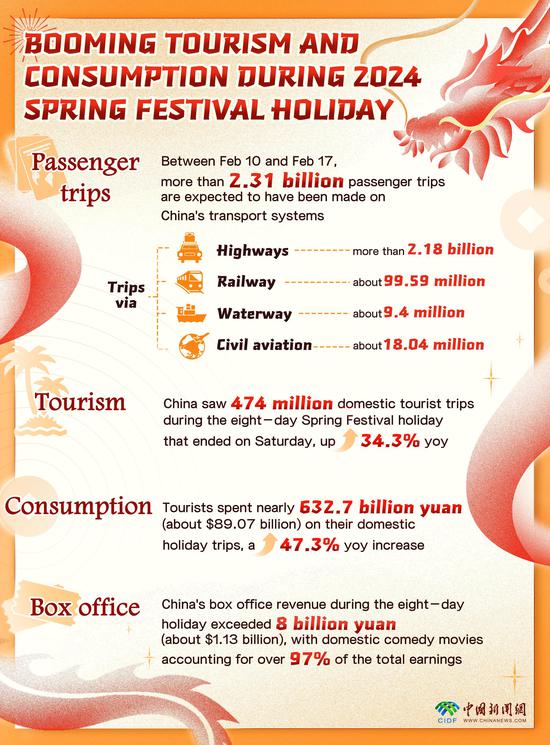(ECNS)—The trend of China's economic growth remains unchanged, and the so-called China decline theory will not resist the trend of "the rise of the East and the decline of the West", an economist said in an article on Sunday.
Several think tanks and media agencies cited China's shrinking GDP measured in dollars in 2023 in their latest reports to substantiate their claims that China's economic prospect is bleak.
"Such analyses lack comprehensiveness, historical perspective, and foresight," argued Guangming Daily columnist Zhang Yongjun, deputy chief economist at the China Center for International Economic Exchanges in Beijing.
Short-term factors cannot determine long-run prospects
Factors including the rise in the U.S. price level and the appreciation of the U.S. exchange rate contributed to an increase in the share of the United States in the world economy, Zhang said. But this will not last long, he added.
Rising prices in the U.S., which led to faster nominal GDP growth, coupled with the appreciation of the U.S. dollar exchange rate, resulted in a slower or even negative nominal growth rate in another country when its GDP is translated into U.S. dollars, according to Zhang.
China's GDP in 2023 shrank in U.S. dollars partly due to a weakening Chinese yuan, or RMB, against the USD, whereas the number measured in RMB expanded 5.2 percent year-on-year after adjusting for inflation, according to the National Statistics Bureau, which indicates that the nation's economy maintained steady growth in the year, Zhang said.
From 2021 to 2023, there was serious inflation in the United States, with U.S. consumer prices rising by 4.7 percent, 8 percent, and 4.1 percent in 2021, 2022, and 2023 respectively, and the nominal GDP subsequently rising.
However, data showed that the share of the United States in the world economy has declined twice in history after a significant rebound.
The first period of U.S. economic recovery occurred from 1981 to 1985. High-interest-rate policy taken by the Federal Reserve (Fed) led to two economic recessions and significant appreciation of the U.S. dollar exchange rate. As a result, the share of U.S. GDP in the world increased from 25.4 percent in 1980 to 34.6 percent in 1985, rising by 9.2 percentage points over the five-year period.
However, this trend saw a rapid decline, from 34.6 percent in 1985 to 24.5 percent in 1995, a drop of 10.1 percentage points.
A similar situation occurred between 1996 and 2001, during which the share of U.S. GDP in the world's total rose from 24.5 percent in 1995 to 31.3 percent in 2001. But after 2003, the figure dropped from 31.3 percent in 2002 to 21.1 percent in 2011, a decrease of 10.2 percentage points.
Developed economies on a downhill slope
Moreover, Zhang pointed out that anemic growth is seen in most advanced economies and the U.S. alone cannot avert the downturn.
Take the G7 as an example, while the U.S. grew by 1.3 percentage points as a part of the global economy in 2022, G7 countries' combined GDP as a share of the world's GDP still dropped by 0.6 percent that year.
Not to mention that the U.S. GDP as a share of the global GDP could drop in 2024 as per predictions by international think tanks.
According to the Conference Board, a U.S. research agency that has long been tracking the periodic changes in the American economy, the U.S. economy is likely to enter stagnation or even negative growth in the third quarter of 2024.
The Fed and International Monetary Fund (IMF) also foresee that the real GDP growth for Uncle Sam in 2024 could decrease to around 2 percent.
And the likelihood of lower interest rates and the dollar depreciation adds more uncertainty to the economic prospects of the world's largest economy.
Chinese economy remains resilient and dynamic
In the meantime, China's favorable policies and strong growth momentum could facilitate the national economy, Zhang wrote.
Multiple research institutions released brisk predictions of China's economic development in 2024, setting the growth figure at around 5 percent or even 6 percent if inflation is considered.
According to the World Economic Outlook report released by the IMF last October, in the years from 2024 to 2028, the U.S. GDP as a share of the world's economy will decline, whereas that of China will be back on track for a steady rise.


















































 京公網安備 11010202009201號
京公網安備 11010202009201號